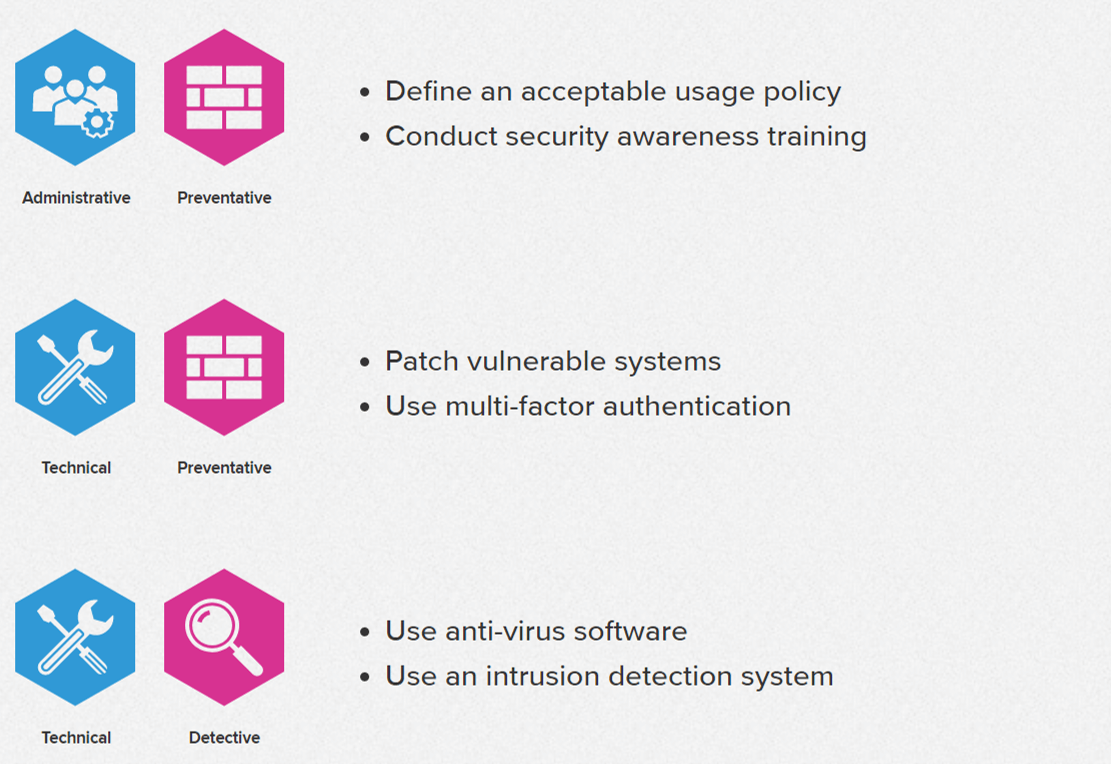Introduction
F5 Labs education articles help you understand basic threat-related security topics.
At the most fundamental level, IT security is about protecting things that are of value to an organization. That generally includes people, property, and data—in other words, the organization’s assets.
Security controls exist to reduce or mitigate the risk to those assets. They include any type of policy, procedure, technique, method, solution, plan, action, or device designed to help accomplish that goal. Recognizable examples include firewalls, surveillance systems, and antivirus software.
Control Objectives First…
Security controls are not chosen or implemented arbitrarily. They typically flow out of an organization’s risk management process, which begins with defining the overall IT security strategy, then goals. This is followed by defining specific control objectives—statements about how the organization plans to effectively manage risk. For example, “Our controls provide reasonable assurance that physical and logical access to databases and data records is restricted to authorized users” is a control objective. “Our controls provide reasonable assurance that critical systems and infrastructure are available and fully functional as scheduled” is another example.
…Then Security Controls
Once an organization defines control objectives, it can assess the risk to individual assets and then choose the most appropriate security controls to put in place. One of the easiest and most straightforward models for classifying controls is by type: physical, technical, or administrative, and by function: preventative, detective, and corrective.
Control Types
Physical controls describe anything tangible that’s used to prevent or detect unauthorized access to physical areas, systems, or assets. This includes things like fences, gates, guards, security badges and access cards, biometric access controls, security lighting, CCTVs, surveillance cameras, motion sensors, fire suppression, as well as environmental controls like HVAC and humidity controls.
Technical controls (also known as logical controls) include hardware or software mechanisms used to protect assets. Some common examples are authentication solutions, firewalls, antivirus software, intrusion detection systems (IDSs), intrusion protection systems (IPSs), constrained interfaces, as well as access control lists (ACLs) and encryption measures.
Administrative controls refer to policies, procedures, or guidelines that define personnel or business practices in accordance with the organization's security goals. These can apply to employee hiring and termination, equipment and Internet usage, physical access to facilities, separation of duties, data classification, and auditing. Security awareness training for employees also falls under the umbrella of administrative controls.
Control Functions
Preventative controls describe any security measure that’s designed to stop unwanted or unauthorized activity from occurring. Examples include physical controls such as fences, locks, and alarm systems; technical controls such as antivirus software, firewalls, and IPSs; and administrative controls like separation of duties, data classification, and auditing.
Detective controls describe any security measure taken or solution that’s implemented to detect and alert to unwanted or unauthorized activity in progress or after it has occurred. Physical examples include alarms or notifications from physical sensor (door alarms, fire alarms) that alert guards, police, or system administrators. Honeypots and IDSs are examples of technical detective controls.
Corrective controls include any measures taken to repair damage or restore resources and capabilities to their prior state following an unauthorized or unwanted activity. Examples of technical corrective controls include patching a system, quarantining a virus, terminating a process, or rebooting a system. Putting an incident response plan into action is an example of an administrative corrective control.
The table below shows how just a few of the examples mentioned above would be classified by control type and control function.
| CONTROL FUNCTIONS | |||||
|---|---|---|---|---|---|
| Preventative | Detective | Corrective | |||
| CONTROL TYPES | Physical | Fences, gates, locks | CCTV and surveillance camera logs | Repair physical damage, re-issue access cards | |
| Technical | Firewall, IPS, MFA solution, antivirus software | Intrusion detection systems, honeypots | Patch a system, terminate a process, reboot a system, quarantine a virus | ||
| Administrative | Hiring and termination policies, separation of duties, data classification | Review access rights, audit logs, and unauthorized changes | Implement a business continuity plan or incident response plan | ||


